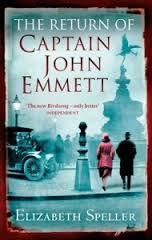 After months of addiction to crime novels, I seem to have rather gone off them, for the moment anyway. But when I saw this recommended on Tales from the Reading Room, a blog I very much like and respect, I was intrigued. Although I suppose it could fit into that genre, as it contains a series of mysterious and obviously linked deaths, there's a great deal more going on here.
After months of addiction to crime novels, I seem to have rather gone off them, for the moment anyway. But when I saw this recommended on Tales from the Reading Room, a blog I very much like and respect, I was intrigued. Although I suppose it could fit into that genre, as it contains a series of mysterious and obviously linked deaths, there's a great deal more going on here.
The Return of Captain John Emmett takes place in 1920. Laurence Bartram has returned from the First World War and is living in London, trying to write a book about church architecture. Lonely and rootless, he is struggling with his memories and with his confused feelings about the death, while he was in France, of his young wife and their baby son. So, when he is contacted by Mary Emmett, the sister of an old school friend, he seizes the opportunity to meet and to help her to solve the mystery of her brother's suicide. John Emmett had survived the war, but had emerged suffering badly from shell shock, for which he was being treated, apparently successfully, at a care home in Oxfordshire. Mary is understandably mystified by the question of why, when he seemed so much better, he should have shot himself and left no letter of explanation. Glad to take on something that will give him a sense of purpose, and glad to be doing it for Mary, who he has always been attracted to, he starts to investigate John's experiences of the war . Puzzling legacies in John's will soon lead Laurence to the discovery that he had been involved in the execution of a young officer by firing squad, and soon other members of the squad seem to be dying in unexplained circumstances...
All this is very well done, but what makes the novel really stand out is the excellence and intelligence of the writing, and the beautifully conceived historical background. John's researches lead him to meet people from all walks of life, from journalists to company directors to engineers, and into environments as diverse as factories and hospitals for recovering shell-shocked soldiers. Then there are the familes on whose lives the war has had an impact, whether the loss of sons or the irreversible physical and mental damage. There are fascinating strands interwoven, including the friendships between young soldier poets, the politics of war, and the readjustment to life for those involved in the conflict whether directly or indirectly.
Impressively, this was Elizabeth Speller's first novel. I have already ordered her next one, The Strange Fate of Kitty Easton, which also features Laurence Bartram, and am looking forward to it very much.
